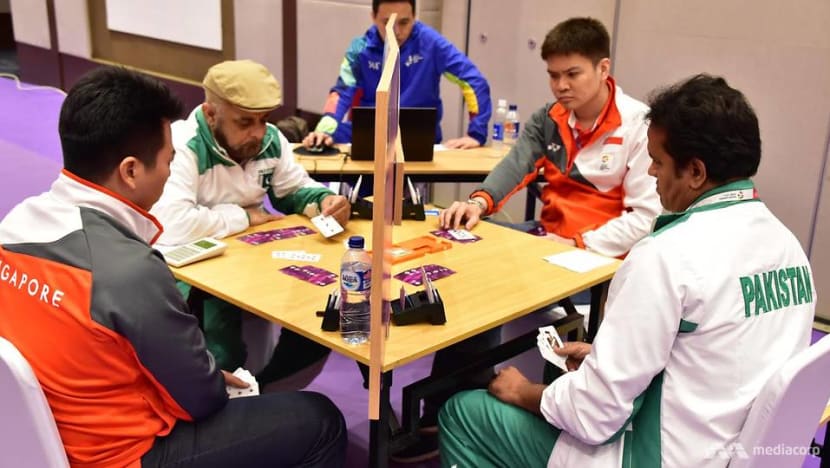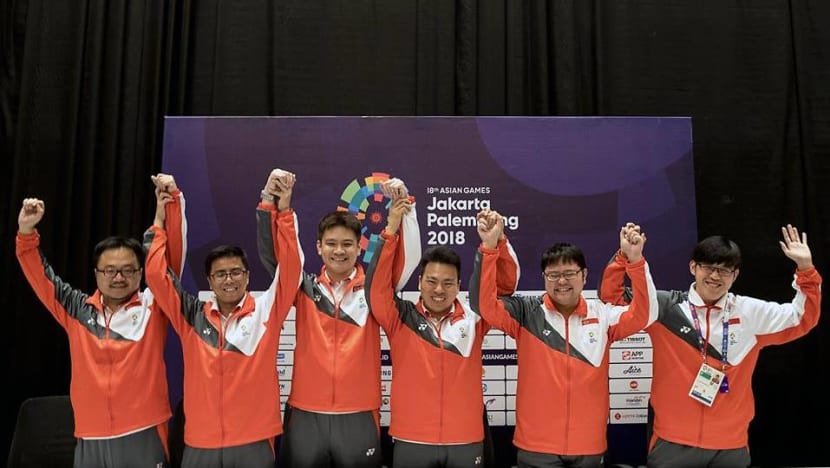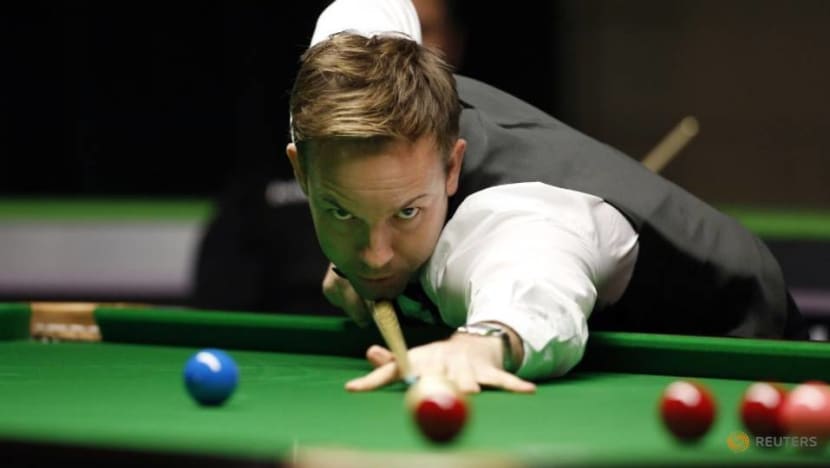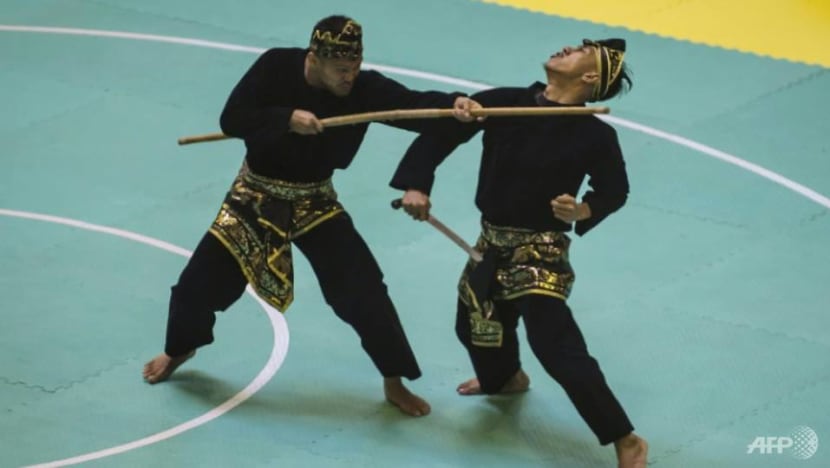commentary Commentary
Commentary: A bridge too far – what makes an activity worthy of inclusion into an international sporting tournament?
Can bridge, or any card game for that matter, be considered a sport?

Singapore's Poon Hua and Loo Choon Chou in action at the 2018 Asian Games. (Photo: Amir Yusof)
SINGAPORE: Bowling. Every time it’s on TV, I jest that anything that can be done while having a pizza, chatting up the opposite sex and drinking beer is not a sport.
But having gone bowling on several occasions, I can safely say that to set the lanes on fire, the beer, the flirting and the pepperoni slice(s) are pretty much non-starters.
For the physical exertions required to bend that knee, get down low and hurl that leaden-like sphere 60 feet to its target can leave one pretty winded. Especially the unfit ones. Like me.
So, for all intents and purposes, bowling is a sport. And one which Singapore has consistently done well in at international competitions over the years.
Like the keglers of yore, bridge exponents have now delivered an Asian Games gold medal for Singapore. Kudos to the six-man outfit for snagging the team title in Jakarta. By all accounts, it was a well-deserved win.

And the question that had tongues wagging when bridge secured a place at the Asian Games became louder and all the more. Can bridge, or any other card game for that matter, be considered a sport?
The short answer: Of course, not.
READ: Is having 'no specific target' tantamount to 'no vision' for Singapore sports? A commentary
WHAT’S A SPORT?
So what makes something a sport? And then, what makes that sport worthy of international competitions? Why is card tossing worthy of inclusion at a sporting tournament and not wife carrying?
“Sport means all forms of physical activity, which through casual or organised participation, aim at expressing or improving physical fitness and mental well-being, forming social relationships or obtaining results in competition at all levels,” says the Council of Europe’s charter on sport.
The terms “physical activity” and “physical fitness” jump at you.
Sure, sitting for hours on end requires some basic skills – and sitting is definitely a physical skill. That, and holding up and putting down your cards, is all the physical movement needed to play bridge. But even that is incidental to the game.
Because, if you are paralysed from the neck down, you can – theoretically – get others to place your cards for you. Although, it is unclear whether such a competitor would be allowed to participate at an Asian Games.
Now that’s something you can’t do in cuesports, which also has its detractors who claim snooker and pool aren’t sport.
Sorry. Time out. Chope. Billiards, snooker, pool: All sports.
READ: Are Singapore’s efforts to be a sporting nation half-hearted? A commentary

Flipping a leg over the table to angle your hips so that you can accurately pot the brown is a stern test of one’s physiology. Believe you me. Whereas, sometimes I struggle to stay awake while I’m getting hammered at UNO.
Competitive eating aficionados like to make noises about how it is a sport. And I can see their point. Necking 93 hamburgers in eight minutes, as the legendary Takeru Kobayashi did in the early 2000s, is a physical feat nonpareil. Period.
The chewing, swallowing and the digesting requires a body in tip-top shape.
One of Singapore’s bridge gold medal winners even acknowledged that while it isn’t a physical activity, bridge can be classified as a “mind sport”. Which is fair enough.
Especially since this form of bridge, contract bridge, is less reliant on luck and more a test of tactics, calculations and strategy. A cerebral pursuit, if you will.
So why don’t we have Scrabble at the Asiad? Or Sudoku? Or how about spelling, which Asians really excel at?
Bridge got its break at the 2018 Asian Games because tobacco tycoon Michael Bambang Hartono, who’s also the president of the South East Asia Bridge Federation, successfully lobbied the Olympic Council of Asia to include it in this edition.
And 78-year-old Hartono, an avid player who has competed at many international bridge tournaments, went on to win bronze in one of the categories.
MAKING THE CUT AT INTERNATIONAL TOURNAMENTS
The Asian Games has a rich tradition of showcasing Asian sports. Kabbadi and sepak takraw have been in the Asiad fold for a while now – and have become popular spectator sports in their own right.
For this edition, Indonesia, as hosts, had a choice of one sport to include and they picked silat. This Malay martial arts sport has been a regular fixture in the Southeast Asian Games and is a worthy inclusion.
READ: Singapore, don’t let this World Cup lesson go to waste, a commentary

Also making their debuts at the Games: Jujitsu, sambo and kurash. The latter two originate in Central Asia and give us some a cultural insight into that part of the world. For I would also argue that the Asian Games should foment better understanding of the more remote reaches of the continent.
I’m, however, not too hot about the bows made by paragliding, rock climbing and rollerblading in Jakarta, but at least they are sports. Lest we forget, the Beijing Olympics had BMX cycling.
But sneaking in bridge does feel a bit disingenuous.
Unlike getting into the Olympics, where International Olympic Committee (IOC) members vote on whether to include a sport in the Games, the Olympic Council of Asia who decides on what to include for the Asian Games does no such thing. The decision to include a sport is taken at a committee level.
The IOC had previously granted bridge the status of a mind sport that has a recognised international sports federation status in the 1990s – along with chess. But it has not included either into the official register because “mind sports, by their nature, cannot be part of the programme”, according to IOC officials.
And just because it’s some bigwig’s passion doesn’t mean it ought to make the grade; doing so merely makes a mockery of the Games.
A more rigorous process is needed for sports, or card games, to make the cut for the Asian Games. Nobody wants to liken Asia’s premier sporting event with Mickey Mouse.
Bridge is a relatively high-profile game and there are numerous, lucrative tournaments which have it front and centre. And that’s where it ought to be – not as a sport at an international sporting event.
I for one would love to see board games at big sporting events. Snakes & Ladders, Pictionary, Trivial Pursuit and even Boggle. What fun that would be. I could finally become a Singapore international athlete.
But … don’t get me started on e-sports.










